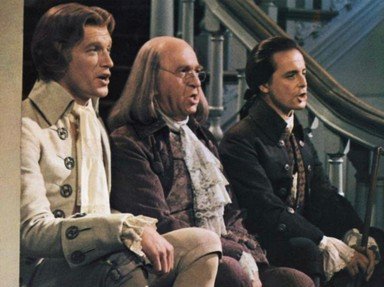Quiz Answer Key and Fun Facts
1. "1776" focuses on the decision of the Second Continental Congress to declare American independence from Great Britain. The most zealous proponent of independence is an "obnoxious and disliked" delegate from Massachusetts. Who is he?
2. The movie begins with one actor/character standing in the cupola of Independence Hall where the Second Continental Congress is meeting. Where is the Congress meeting?
3. In the first real outdoor and daytime scene, John Adams speaks with Benjamin Franklin. What is Franklin doing when Adams meets with him?
4. Virginia has proposed independence and the Continental Congress has created a committee of five to write the Declaration of Independence. None of the committee members, however, want to write the Declaration and each member has an excuse. Which delegate is not properly matched with his excuse?
5. In the early part of the movie, John Hancock has been upset because one of the state/colony delegations has been absent. This is remedied when Rev. Jonathan Witherspoon and his colleagues arrive. Which state do they represent?
6. Other historic figures are referenced in the course of the movie. One figure, while he is never seen onscreen, sends numerous dispatches from the Continental Army that are read to the Congress. Which military figure is this?
7. One of the features of "1776" that stands out is the lack of female roles. There are only two females--both historic women--who are named and have dialogue/songs in the whole movie. Who is not one of these women?
8. As they listen to the Declaration being read for the first time, Adams, Jefferson, and Franklin sign a song, "The Egg", about the birth of a new nation. Each man has proposed a different bird as the symbol of the United States. Which bird was not proposed?
9. During the reading of the Declaration, Edward Rutledge of South Carolina objects to the inclusion of a specific issue in the document. Which issue does Rutledge not want mentioned in the Declaration?
10. The vote on independence finally comes down to Pennsylvania. The individual delegates are polled as to their opinions. Which delegate votes against independence?
Source: Author
bernie73
This quiz was reviewed by FunTrivia editor
skunkee before going online.
Any errors found in FunTrivia content are routinely corrected through our feedback system.

